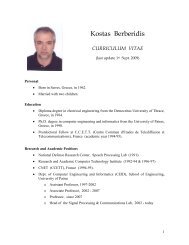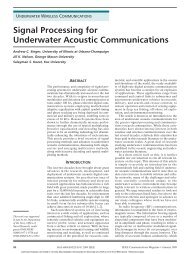Perspectives for present and future CDMA-based ... - IEEE Xplore
Perspectives for present and future CDMA-based ... - IEEE Xplore
Perspectives for present and future CDMA-based ... - IEEE Xplore
Create successful ePaper yourself
Turn your PDF publications into a flip-book with our unique Google optimized e-Paper software.
MULTIPLE ACCESS TECHNOLOGIES FORB3G WIRELESS COMMUNICATIONS<strong>Perspectives</strong> <strong>for</strong> Present <strong>and</strong> Future<strong>CDMA</strong>-Based Communications SystemsRomano Fantacci, Francesco Chiti, Dania Marabissi, Giada Mennuti, Simone Morosi, <strong>and</strong> Daniele Tarchi,Università di FirenzeABSTRACTIn this article the main boosters of <strong>future</strong><strong>CDMA</strong> communication systems are <strong>present</strong>ed<strong>and</strong> described in order to highlight ways to copewith the more challenging requirements <strong>future</strong>systems <strong>and</strong> services claim. Particular attentionis devoted to the inherent weak points of <strong>CDMA</strong>systems <strong>and</strong> detection techniques that can beused to overcome their impairments. Moreover,high-data-rate transmissions in wireless channelsrequire proper link adaptation techniques; theseare thoroughly described as well. Finally, the lastpart of this article focuses on the design of suitableprotocol strategies <strong>for</strong> new heterogeneousmultimedia packet services characterized bystrict QoS requirements.INTRODUCTIONIn recent years the increased dem<strong>and</strong> <strong>for</strong>advanced wireless communication services hasled to the definition of more <strong>and</strong> more powerfulsystems. Third-generation (3G) mobile serviceshave just begun, <strong>and</strong> in the 3G Partnership Project(3GPP) 3G enhancement activity has alreadystarted. Furthermore, various wireless researchorganizations such as the Wireless WorldResearch Forum (WWRF) <strong>and</strong> InternationalTelecommunication Union (ITU) are holdingactive discussions about systems beyond 3G tobe deployed around 2010. For next-generationmobile wireless systems, high data rates <strong>and</strong> customizablesystems enabled by flexible technologiesare envisaged. In order to satisfy the highdata rate requirement <strong>and</strong> efficiently supportmultimedia services, modulation <strong>and</strong> multipleaccess schemes must be spectrally efficient <strong>and</strong>flexible. Code-division multiple access (<strong>CDMA</strong>)<strong>and</strong> orthogonal frequency-division multiplexing(OFDM) are two of the most promising c<strong>and</strong>idates,as well as hybrid schemes <strong>based</strong> on bothtechniques. In particular, <strong>CDMA</strong> has emergedas the predominant radio access technology toprovide multimedia services in 3G systems. However,high-data-rate transmissions with quality ofservice (QoS) requirements are strongly influencedby the propagation conditions of themobile wireless channel <strong>and</strong> multiple accessinterference due to simultaneous users. As aconsequence, to achieve efficient utilization ofthe limited radio spectrum <strong>and</strong> allow contemporaryconnections with different QoS requirements,remarkable improvements in both thewireless physical (advanced detection schemes,multiple antennas, coding, etc.) <strong>and</strong> link layer(access control, b<strong>and</strong>width allocation, etc.) arerequired.This article deals with some of these promisingapproaches <strong>and</strong> schemes of special interestin <strong>future</strong> beyond 3G wireless networks wherebursty high-speed traffic is <strong>for</strong>eseen, <strong>and</strong>advanced detection schemes <strong>and</strong> high b<strong>and</strong>widthefficiency are pursued. The outline of this articleis as follows. We deal with physical layer issuesbyproviding a brief survey of the principal detectionschemes. We also include discussions of theadvantages af<strong>for</strong>ded by efficient detectionschemes with antenna array systems. We dealwith link layer issues: following a brief introductionto the principles of adaptive modulation<strong>and</strong> coding (AMC), a suitable scheme <strong>for</strong> efficientAMC implementation in 3G <strong>and</strong> B3G systemsis described. In addition, to increase servicereliability, a novel scheme that combines turbocodes’ advantages with those of efficient automaticrepeat request (ARQ) schemes is discussed.We then deal with radio resourcemanagement aspects including admission control,power control, <strong>and</strong> scheduling schemes.Finally, conclusions are drawn.PHYSICAL LAYER ISSUESThis section deals with physical layer issues. Inparticular, some advanced receiving approachesare discussed herein. In addition, a brief discussionof multicarrier <strong>CDMA</strong> (MC-<strong>CDMA</strong>) is provided.ADVANCED DETECTION TECHNIQUESAs is well known, the benefits of the directsequence (DS)-<strong>CDMA</strong> technique can be summarizedas a potential increase of system capaci-<strong>IEEE</strong> Communications Magazine • February 2005 0163-6804/05/$20.00 © 2005 <strong>IEEE</strong>95
NoReliable signalscancellationRake (MRC)In<strong>for</strong>mative bitdecisionUnreliable usersBaseb<strong>and</strong>received signal r(t)Rake (MRC)> Threshold?ear detectors are the decorrelating <strong>and</strong> minimummean square error (MMSE) detectors [1].The <strong>for</strong>mer per<strong>for</strong>ms the inverse of a cross-correlationmatrix with matched filter outputs inorder to decouple the data. The latter implementslinear trans<strong>for</strong>mation that minimizes themean squared error between the actual data <strong>and</strong>the soft output of the conventional detector.Interference cancellation receivers explicitlyestimate the overall interference due to multipleaccess <strong>and</strong> multipath <strong>for</strong> each received signal,then subtract it from the received signal be<strong>for</strong>emaking a data decision [1]. IC receivers havelower implementation complexity than lineardetectors, so they are widely considered <strong>for</strong><strong>future</strong> applications.As described in the literature, IC can be per<strong>for</strong>medin parallel (i.e., simultaneously) <strong>for</strong> allusers, resulting in a parallel IC (PIC) receiver,or in a serial way, resulting in a successive IC(SIC) receiver [1].Of special interest <strong>for</strong> multirate applicationsare receivers <strong>based</strong> on the groupwise approachin which user signals are divided into groups(e.g., according to their spreading factor). Symboldetection <strong>and</strong> interference estimation areper<strong>for</strong>med <strong>for</strong> signals within the same group.Hence, the associated interference effects aresubtracted from signals in other groups. A specialcase of groupwise IC receiver is the selectivePIC (SPIC) receiver proposed <strong>and</strong> analyzed in[2, 3]. In this case user signals are divided intoreliable <strong>and</strong> unreliable signal groups <strong>based</strong> oncomparisons of the decision variables with aproper threshold value. Reliable signals aredirectly detected <strong>and</strong> (after signal reconstruction)canceled from the whole received signal.Unreliable signals are detected after cancellationof the MAI effects due to reliable signals. In Fig.1 a block scheme of an SPIC receiver is shown.It is shown in [3] that the SPIC receiverachieve almost the same per<strong>for</strong>mance as the PICreceiver with the advantage of lower implementationcomplexity.Recently, advanced receiving schemes havebeen developed by taking into account that practical<strong>CDMA</strong> communication systems rely on theuse of error control coding <strong>and</strong> interleavingschemes. Optimal joint decoding/detection methodsallow excellent per<strong>for</strong>mance to be achieved,but un<strong>for</strong>tunately require prohibitive computationalcomplexity <strong>for</strong> actual applications. Tolower this drawback, suboptimal solutions inwhich symbol detection <strong>and</strong> channel decodingare per<strong>for</strong>med <strong>and</strong> optimized separately havebeen proposed [1]. In particular, the successfulproposal of turbo codes [4] has led to the definitionof powerful MUD receivers <strong>based</strong> on theiterative (turbo) processing technique. In iterativeMUD, extrinsic in<strong>for</strong>mation is determinedin each detection <strong>and</strong> decoding stage, <strong>and</strong> usedas a priori in<strong>for</strong>mation <strong>for</strong> the next iteration.This procedure is adopted at each iteration, as inturbo codes; this detection philosophy is definedas turbo MUD, <strong>and</strong> the advantages of its introductionare remarkable <strong>for</strong> heavily loaded systemsas well. Even if turbo MUD receivers stillhave the drawback of high implementation complexity,they re<strong>present</strong> a promising approach toenhance per<strong>for</strong>mance in <strong>future</strong> high-speed mulnFigure 1. A block scheme of the SPIC receiver.YesIn<strong>for</strong>mative bitdecisionReliableusersty, the ability to support universal frequencyreuse, graceful degradation under loaded conditions,soft h<strong>and</strong>off capability, easy adaptation tovariable-rate services, low power flux densityemission, <strong>and</strong> finally, the possibility of using classicaldiversity techniques to cope with multipathfading effects. On the other h<strong>and</strong>, this techniqueis basically interference limited (i.e., per<strong>for</strong>manceis limited by multiple access interference,MAI). Hence, suitable detection schemes haveto be considered in order to lower this drawback.The traditional DS-<strong>CDMA</strong> detection techniqueis <strong>based</strong> on the use of a correlation receiverin which signals of additional users areconsidered pure interference. Hence, if a correlatorreceiver is used, the MAI limits the numberof active users in relation to a specified biterror rate (BER) value. Another shortcoming isits vulnerability to the near-far effect (i.e.,impairments due to the strongest signals onweak ones), which m<strong>and</strong>ates tight implementationof the power control scheme to prevent per<strong>for</strong>mancefrom excessive degradations. Duringrecent years more efficient detection schemes,multiuser detection (MUD) receivers, have beenproposed <strong>and</strong> investigated as a potential methodto improve <strong>CDMA</strong> system per<strong>for</strong>mance [1]. Themain feature of MUD receivers is joint detectionof all received signals to eliminate the near-farproblem <strong>and</strong> increase system capacity.The optimal MUD receiver, <strong>for</strong>med by abank of matched filters followed by the Viterbialgorithm (i.e., maximum likelihood sequenceestimator, MLSE), has implementation complexity(exponential in the number of users) prohibitive<strong>for</strong> wide adoption in practicalapplications. Hence, research ef<strong>for</strong>ts havefocused on suboptimal MUD approaches, classifiedinto linear <strong>and</strong> interference cancellation(IC) MUD receivers [1]. In linear MUD receivingschemes, a linear trans<strong>for</strong>mation is appliedto the matched filter outputs to reduce the MAIeffects on each user. The two most popular lin-96<strong>IEEE</strong> Communications Magazine • February 2005
In recent years,Multi-Carriersystems, <strong>based</strong> onOFDM <strong>and</strong> <strong>CDMA</strong>schemes, have beenthe subject ofextensive researchto efficientlyevaluate thefeasibility of suchnew air interfacec<strong>and</strong>idate.requirements is an OFDM-<strong>based</strong> system. TheOFDM technique is robust against severe multipathfading <strong>and</strong> can be efficiently implementedby means of fast Fourter trans<strong>for</strong>m(FFT)/inverse FFT (IFFT). In recent years, multicarrier(MC) systems <strong>based</strong> on OFDM <strong>and</strong><strong>CDMA</strong> have been the subject of extensiveresearch to efficiently evaluate the feasibility ofa such new air interface c<strong>and</strong>idate.A comprehensive overview of different solutionscombining OFDM <strong>and</strong> <strong>CDMA</strong> to overcometheir inherent limits (e.g., lack of efficientmultiple access in OFDM, the near-far effect<strong>and</strong> cumbersome structure to combat fading in<strong>CDMA</strong>) was accurately carried out in [7].Advantages provided by these solutions are efficientexploitation of energy scattered in the frequencydomain, robustness toward fading, <strong>and</strong>the high data rates achievable.LINK LAYER TOPICSThis section deals with two main link layer topics:adaptive modulation <strong>and</strong> coding techniques<strong>and</strong> hybrid ARQ protocols.ADAPTIVE MODULATION ANDCODING TECHNIQUESAdaptive modulation <strong>and</strong> coding (AMC) belongsto the class of link adaptation (LA) algorithms.The basic idea behind LA techniques is to adapttransmission parameters to take advantage ofchannel conditions. The fundamental parametersto be adapted include modulation <strong>and</strong> codinglevels, but other quantities can be adjusted, suchas power levels (as in power control), spreadingfactors, <strong>and</strong> signaling b<strong>and</strong>width. LA is nowwidely recognized as a key solution to increasethe spectral efficiency of wireless systems. Animportant indication of the popularity of suchtechniques is the current proposals <strong>for</strong> 3G wirelesspacket data services, such as UniversalMobile Telecommunications System (UMTS), aswell as 2.5G, such as General Packet Radio Service(GPRS), to provide a higher data rate.One of the main challenges <strong>for</strong> LA is knowledgeof the channel parameters, because ofdelay in feedback response <strong>and</strong>, on the otherh<strong>and</strong>, channel parameters changing due to thefading nature of the wireless medium.AMC is one method used in order to per<strong>for</strong>mLA in wireless networks. AMC techniques workby defining some schemes, each characterized bydifferent modulation <strong>and</strong> coding types (modulation<strong>and</strong> coding scheme, MCS); in a systemwhere LA is per<strong>for</strong>med using AMC, the bestMCS in terms of throughput maximization isselected, considering that in an environmentwith low SNR it is better to use low-order modulation<strong>and</strong> coding, while in a high SNR environmentit is better to use high-order modulation<strong>and</strong> coding.With AMC, the power of the transmitted signalis held constant, but the modulation <strong>and</strong>coding <strong>for</strong>mats are changed to match the currentreceived signal quality. In a system with AMC,users close to the base station are typicallyassigned higher-order modulations <strong>and</strong> highcode rates (e.g., 64-quadrature amplitude modulation[QAM] with rate-3/4 convolutional coding),but the modulation order <strong>and</strong>/or code ratewill decrease as distance from the base stationincreases.The choice of the best scheme is madeaccording to the measure of some parameterstaking into account the channel state in<strong>for</strong>mationin order to adapt the modulation <strong>and</strong> codingscheme. The in<strong>for</strong>mation to be monitoredcan include a great variety of parameters. Forexample, a <strong>CDMA</strong>-<strong>based</strong> system is more vulnerableto power unbalance, so in its case it is betterto monitor the received power fluctuation ormultiple access interference.The channel state in<strong>for</strong>mation (CSI) can bemonitored in two main ways: direct <strong>and</strong> indirectmode. In direct mode the channel state is measuredusing some pilot symbols <strong>and</strong> verifying atthe receiving end if the received power is withina specific range, while in the indirect methodspecific in<strong>for</strong>mation such as the acknowledgment(ACK)/negative ACK (NACK) packets relatedto the reliability of the received in<strong>for</strong>mation areused. Increasing interest in AMC techniques isshown by the attention devoted to them in thedefinition of some new telecommunications systemssuch as Enhanced Data Rate <strong>for</strong> GSMEvolution (EDGE), while <strong>for</strong> 3G system anextension of UMTS, high-speed downlink packetaccess (HSDPA), is <strong>for</strong>eseen <strong>based</strong> on the use ofsuitable AMC techniques to improve per<strong>for</strong>mancein terms of throughput.HYBRID ARQ PROTOCOLSThe traditional approach to establish a reliablelink-to-link connection is <strong>based</strong> on adding ARQprotocols to the logical link control (LLC); thebasic schemes are Stop <strong>and</strong> Wait (SW), Go BackN (GBN), <strong>and</strong> Selective Repeat (SR). The aboveschemes show increasing implementation complexitycounterbalanced by better throughput(i.e., lower average number of retransmissionsneeded to successfully deliver a packet).The wireless communication paradigm causesbursts of errors to occur during which packetscannot be successfully transmitted on the link,<strong>and</strong> proper error detection <strong>and</strong> correction techniquesare needed without drastically reducingspectral efficiency.In this case, to lower residual error rate <strong>and</strong>hence allow reliable services, powerful channelcoding schemes have been proposed [8]; amongthem, the best c<strong>and</strong>idates seem to be turbocodes [4]. The main drawback of this approach,commonly called <strong>for</strong>ward error correction(FEC), is re<strong>present</strong>ed by added redundancy thatdrastically reduces system throughput. HybridARQ (H-ARQ) techniques keep the advantagesoffered by previous approaches together withmitigation of the typical drawbacks, thus settingup highly mobile <strong>and</strong> reliable end-to-end connections.Basically there are three H-ARQ schemes:type I H-ARQ, in which each packet can beindependently decoded, thus discarding erroneouspackets; type II H-ARQ, in which jointpacket decoding is carried out by keeping trackof each message’s decoding results in a memorybuffer; <strong>and</strong> type III H-ARQ, in which the MCSsare varied according to the transmission out-98<strong>IEEE</strong> Communications Magazine • February 2005
come. One of the most promising type II H-ARQ schemes is <strong>based</strong> on uncorrelated datacombination, often called packet combining. Thispermits the Euclidean distance between thecodewords <strong>and</strong> the received sequence to be maximized,as shown in [9], thereby minimizing theerroneous detection probability. Packet combiningcan be <strong>based</strong> on either hard decision outputsor on soft channel outputs. In particular, two differenttype II H-ARQ schemes <strong>based</strong> on softcombining are possible: input <strong>and</strong> output combinedtype II ARQ. In the <strong>for</strong>mer the additionalin<strong>for</strong>mation to be combined with the actualpacket may be a received frame replica, while inthe latter it is extrinsic in<strong>for</strong>mation provided bythe decoding of the previous frame. The choicedepends mostly on the reliability of the decodingprocess that can increase or decrease soft output’sreliability. As an example, Fig. 3 sketchesthe block diagram of a receiver scheme in whichoutput combined type II ARQ is adopted.Demodulator Decoder CRC checkPreviousINSICLogicn Figure 3. A receiver scheme with output combined type II ARQ.New callSOCPreviousOUTACK/NACK + CSIRADIO RESOURCEMANAGEMENT ASPECTSFuture wireless systems ought to supply userswith a wide range of different multimedia applications,combining real-time with data services<strong>and</strong> supporting different QoS requirements. As aconsequence, flexible radio resource management(RRM) policies, suitable to varying trafficconditions become crucial. RRM functionsinclude all procedures implemented to dynamicallymanage radio resources in order to meetthe instantaneous dem<strong>and</strong>s of users movingaround in cells, providing data delivery withappropriate end-to-end QoS guarantees. Theywill impact overall system efficiency, so they willdefinitely play an important role in <strong>future</strong> wirelessnetworks [10]. We briefly discuss belowthree main topics in the definition of a suitableRRM scheme: admission control, power control,<strong>and</strong> scheduling.PowerreconfigurationSINR estimationAdmission controlSINR < SINR targetNoAcceptn Figure 4. An admission control scheme.ADMISSION CONTROLIn <strong>CDMA</strong> systems, where b<strong>and</strong>width is ashared resource, special attention must be paidto MAI arising among active connections. Inparticular, significant QoS degradations mayarise if this parameter is not kept under controlby limiting the number of active communications.This goal is achieved by the use ofproper admission control (AC) algorithms. Thetypical AC scheme preserves ongoing connections’QoS by rejecting new connections wheneverit is <strong>for</strong>eseen that they could causeunacceptable degradation of active communications(i.e., outage problems).The simplest AC allows admission of anincoming request if <strong>and</strong> only if the total numberof users does not exceed a specified limit definedduring the network planning phase.Conversely, dynamic AC algorithms are <strong>based</strong>on measurements or estimations of the actualsystem load or interference level, so a variablenumber of connections may be h<strong>and</strong>led in relationto actual conditions. An alternativeapproach is that of considering the AC schemein conjunction with power control or adaptiveratetransmission. As an example of such anapproach, Fig. 4 illustrates its basic functionalblocks. Typical gain values in terms of additionalaccepted data connections under very high calltraffic load conditions with respect to staticapproaches are greater than 60 percent.POWER CONTROLOne of the main widely investigated aspects ofdefined RRM wireless networks is, undoubtedly,power control. In particular, power control ismainly considered in order to improve systemper<strong>for</strong>mance in a shared scenario. Minimizingpower consumption is the main objective of anypower control algorithm. This leads to maintainingthe necessary QoS by compensating <strong>for</strong> terminalmovements, fluctuating interference, <strong>and</strong>channel degradation due to shadowing or multipathfading. But the benefits of a properapproach can be various; on one h<strong>and</strong>, lowerpower means lower interference <strong>and</strong> there<strong>for</strong>eincreased network capacity; on the other h<strong>and</strong>, itreduces the problem of battery life in mobile terminals.Special <strong>and</strong> more efficient approachescan be applied <strong>for</strong> multimedia applicationswhose delay requirements are not too stringent,which is the case <strong>for</strong> packet communications.Indeed, <strong>for</strong> this kind of application the QoSparameters are mainly related to the BER, whilea certain delay in data transmission can beYesBlock<strong>IEEE</strong> Communications Magazine • February 2005 99
Quite apart fromwhich solution willovercome, it seemsreasonablethat <strong>future</strong>communicationssystems will becharacterizedby highlydynamic resourcemanagement <strong>and</strong>extreme flexibility indeployment <strong>and</strong>implementation.accepted <strong>and</strong>, in some cases, not even perceived.This peculiarity allows further refinement of PCalgorithms suitable <strong>for</strong> multimedia networks:when observing high interference in the channel,instead of using high power to overcome thisnoise <strong>and</strong> transmit a packet successfully, it canbe more advisable to postpone transmission,buffer the delay-tolerant traffic, <strong>and</strong> wait <strong>for</strong> theinterference to subside be<strong>for</strong>e transmittingagain.SCHEDULINGDue to the high number of different applicationsenvisaged <strong>for</strong> next-generation wireless networks,priority-<strong>based</strong> management of different queuesmust be supported in order to meet user requirementsin terms of QoS <strong>and</strong> cope with trafficburstiness. Moreover, the management policy ofevery single buffer must consider the nature oftraffic in terms of delay constraints (e.g., realtimeor non-real-time applications). Then thisapproach requires careful monitoring of bothchannel conditions <strong>and</strong> buffer occupation inorder to efficiently schedule the different typesof traffic. A scheduling technique is efficient inany <strong>CDMA</strong>-<strong>based</strong> scenario where flexible use ofthe spectrum could be achieved <strong>and</strong> differentQoS constraints must be satisfied.CONCLUSIONSFor <strong>future</strong> next-generation mobile telecommunications,the goals are high data rates <strong>and</strong> customizableapplications enabled by flexibletechnologies, assuring <strong>for</strong> the user a ubiquitoussystem that is able to always guarantee a connection.To realize this aim two possible scenariosare envisioned. One expects the definition of anew st<strong>and</strong>ard that substitutes the previous 3Gsystems <strong>and</strong> eliminates those problems thatmake 3G networks unsuitable <strong>for</strong> high-data-ratemultimedia applications. Alternatively, a wirelessinfrastructure <strong>based</strong> on the integration <strong>and</strong>interoperability of different wireless systems canbe supposed. Quite apart from which solutionwill overcome, it seems reasonable that <strong>future</strong>communications systems will be characterized byhighly dynamic resource management <strong>and</strong>extreme flexibility in deployment <strong>and</strong> implementation.Hence, <strong>CDMA</strong> re<strong>present</strong>s one of themost promising technologies <strong>for</strong> <strong>future</strong> beyond3G systems. However, to provide enhanced serviceswith high data rates some key technologiesare needed. This article has discussed some ofthem, such as advanced receivers, multipleantennas, adaptive link layers, <strong>and</strong> resourcemanagement techniques.REFERENCES[1] D. Koulakiotis <strong>and</strong> A. H. Aghvami, “Data Detection Techniques<strong>for</strong> DS/<strong>CDMA</strong> Mobile Systems: A Review,” <strong>IEEE</strong> Pers.Commun., vol. 7, no. 3, June 2000, pp. 24–34.[2] R. Fantacci, “Proposal of an Interference CancellationReceiver with Low Complexity <strong>for</strong> DS/<strong>CDMA</strong> MobileCommunication Systems,” <strong>IEEE</strong> Trans. Vehic. Tech., vol.48, no. 4, July 1999, pp. 1039–46.[3] R. Fantacci, D. Marabissi, <strong>and</strong> S. Morosi, “Per<strong>for</strong>manceAnalysis <strong>and</strong> Optimization of a Space-time Selective PIC<strong>for</strong> <strong>CDMA</strong> System,” <strong>IEEE</strong> Trans. Wireless Commun., vol.3, no. 2, Mar. 2004, pp. 359–66.[4] C. Berrou <strong>and</strong> A. Glavieux, “Near Optimum Error CorrectingCoding <strong>and</strong> Decoding: Turbo-codes,” <strong>IEEE</strong>Trans. Commun., vol. 44, Oct.1996, pp. 1261–71.[5] X. Wang <strong>and</strong> H. V. Poor, Wireless Communication Systems,Prentice Hall, 2004.[6] R. D. Murch <strong>and</strong> K. B. Letaief, “Antenna Systems <strong>for</strong>Broadb<strong>and</strong> Wireless Access,” <strong>IEEE</strong> Commun. Mag., vol.40, no. 4, Apr. 2002, pp. 73–86.[7] L. Hanzo et al., OFDM <strong>and</strong> MC-<strong>CDMA</strong> <strong>for</strong> Broadb<strong>and</strong>Multiuser Communications, Wiley, 2003.[8] D. J. Costello <strong>and</strong> S. Lin, Error <strong>and</strong> Control Coding: Fundamentals<strong>and</strong> Applications, Prentice Hall, 1983.[9] D. Chase, “Code Combining, a Maximum LikelihoodApproach <strong>for</strong> Combining an Arbitrary Number of NoisyPackets,” <strong>IEEE</strong> Trans. Commun., vol. 33, May 1985, pp.385–93.[10] J. S. Blogh <strong>and</strong> L. Hanzo, Third-Generation Systems<strong>and</strong> Intelligent Wireless Networking, Wiley,2002.BIOGRAPHIESROMANO FANTACCI [M’87, SM’91, F’05] is a full professor oftelecommunication networks <strong>and</strong> digital communicationsat the University of Florence, Italy. He received the IEE IEREBenefactor Premium in 1990 <strong>and</strong> an <strong>IEEE</strong> ComSoc Award<strong>for</strong> Distinguished Contributions to Satellite Communicationsin 2002, <strong>and</strong> is currently serving as Associate Editor<strong>for</strong> <strong>IEEE</strong> Transactions on Communications <strong>and</strong> <strong>IEEE</strong> Transactionson Wireless Communications.FRANCESCO CHITI [StM’01] received a degree in telecommunicationsengineering <strong>and</strong> a Ph.D. degree in in<strong>for</strong>matics <strong>and</strong>telecommunications engineering from the University of Florencein 2000 <strong>and</strong> 2004. His current research topics aredevoted to MAC, LLC, <strong>and</strong> network layer protocols <strong>for</strong> bothpublic <strong>and</strong> private wireless communications systems as wellas ad hoc <strong>and</strong> sensor networks. He has taken part in severalEuropean research projects, such as as IP GoodFood,NoEs Nexway <strong>and</strong> Newcom, <strong>and</strong> the COST 289 action.DANIA MARABISSI [StM’00] received a Ph.D. degree in in<strong>for</strong>mation<strong>and</strong> telecommunications engineering from the Universityof Firenze in 2004. She joined the Electronic <strong>and</strong>Telecommunications Department at the University of Florencein 2000. She currently conducts research on physicallayer design <strong>for</strong> spread-spectrum wireless systems. In particular,her interests include multiple access techniques,multi-user detection, <strong>and</strong> channel estimation in 3G <strong>and</strong>B3G mobile communications.GIADA MENNUTI [StM’03] received her degree in telecommunicationsengineering from the University of Firenze in2002 <strong>and</strong> is currently working toward her Ph.D. at thesame university. Her research interests mainly include MAC,LLC, <strong>and</strong> network layers, with special attention on resourcemanagement, in wireless communications in 3G <strong>and</strong> B3Gsystems. She is involved in two Network of Excellence(Newcom, Satnex) projects <strong>and</strong> the COST 289 actions.SIMONE MOROSI [StM’98, A’01, M’03] received a Ph. D.degree in in<strong>for</strong>mation <strong>and</strong> telecommunication engineeringin 2000 from the University of Firenze. Since 1999 he hasbeen a researcher of the Italian Interuniversity Consortium<strong>for</strong> Telecommunications (CNIT). Since 2000 he has beenwith the Department of Electronics <strong>and</strong> Telecommunicationsof the University of Firenze. His <strong>present</strong> researchinterests involve <strong>CDMA</strong> communications, multi-user detectiontechniques, <strong>and</strong> B3G mobile communications.DANIELE TARCHI [StM’98] received a Ph.D. degree in in<strong>for</strong>matics<strong>and</strong> telecommunications engineering in 2004 from theUniversity of Florence. He is involved in several national projects(Rescue <strong>and</strong> Pattern) as well as European IP (Good-Food) <strong>and</strong> Network of Excellence (Nexway, Newcom, Satnex)projects. He is involved in COST 289 European Union actions.He has served as a Technical Program Committee member<strong>for</strong> <strong>IEEE</strong> VTC 2004-Spring <strong>and</strong> <strong>IEEE</strong> ICC 2005.100 <strong>IEEE</strong> Communications Magazine • February 2005









